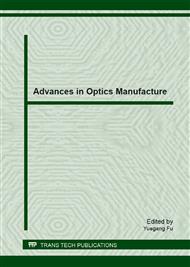p.271
p.276
p.281
p.287
p.292
p.298
p.305
p.313
p.319
Study on High Temperature Stability of Off-Axis Aspherical Collimator
Abstract:
The collimator is a kind of necessary optical instrument for camera in the assembly, adjustment, and test process. In order to meet the high precision camera test requirements within the temperature in a range of 20°C±10°C, a set of off-axis aspherical collimator with high accuracy and high temperature stability is designed. Mirrors use silicon carbide materials. Collimator tube is made of Indium steel materials. After finite element analysis, difference value of the linear expansion coefficient kept within a certain range and reasonable reflector support and the collimator can keep accurate stability within a certain temperature range. After test, off-axis collimator with Ф400mm diameter and, 8m focal length at 20°C±10°C, the wavefront aberration is kept in the range from1/5λ(P-V, λ=632.8nm) to 1/30λ(RMS).The precision of the collimator can meet design requirement.
Info:
Periodical:
Pages:
292-297
Citation:
Online since:
May 2013
Authors:
Price:
Сopyright:
© 2013 Trans Tech Publications Ltd. All Rights Reserved
Share:
Citation:


